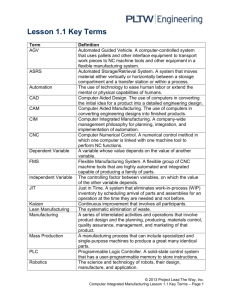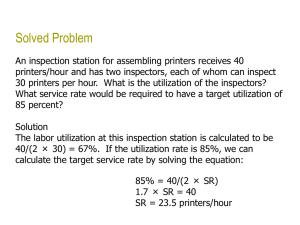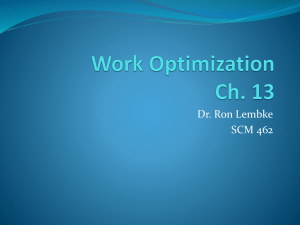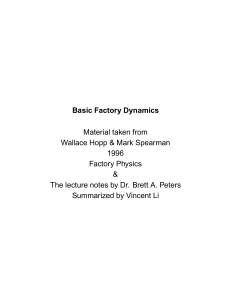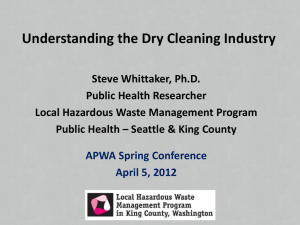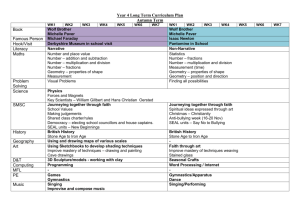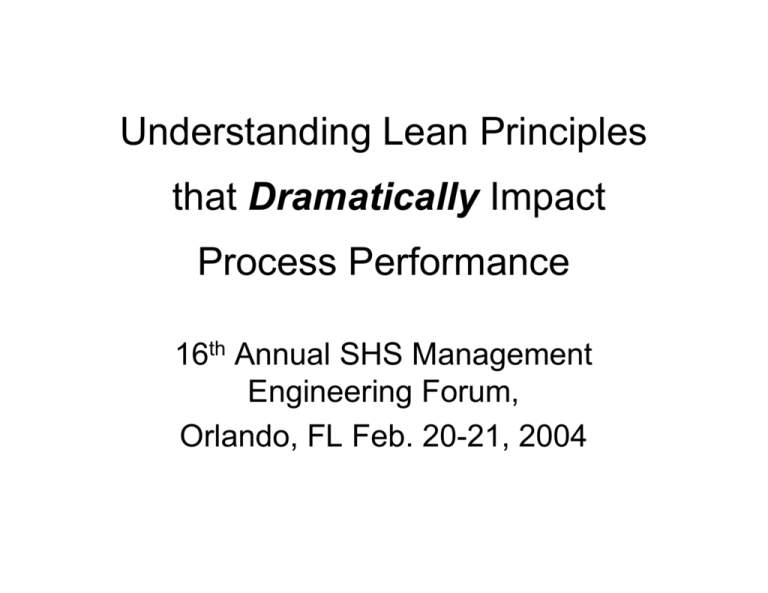
Understanding Lean Principles
that Dramatically Impact
Process Performance
16th Annual SHS Management
Engineering Forum,
Orlando, FL Feb. 20-21, 2004
Facilitators
• Chuck Cox, George Group LLC, Dallas, TX
– Lean Master, Master Black Belt, Certified Six
Sigma Black Belt and Certified Quality
Engineer (ASQ), and Certified Management
Consultant (IMC-USA)
• Chuck Monroe, Pegasus Organization, Inc.,
Scottsdale, AZ
– Master Black Belt, Certified Six Sigma Black
Belt (ASQ) and Certified Management
Consultant (IMC-USA)
All rights reserved, George Group Consulting LP
2
Some Lean Principles
• Little’s Law – drives consistency in process’
cycle time and allows rapid re-prioritization
• Process Flow – balances the work load to
increase throughput with same resources
• Set-up time reduction – provides greater
productivity, revenue & profits from expensive
assets and/or constrained resources
• Waste Identification & Elimination – reduces
non-value added operations
All rights reserved, George Group Consulting LP
3
Key Lean Concepts
Process Cycle Time
Goal:
Today
Reduce Tomorrow
Cycle Time Interval
Goal:
Throughput (Capacity)
Today
Reduce cycle time,
Increase no. of cycles,
Decrease amount in each
All rights reserved, George Group Consulting LP
Tomorrow
Goal:
Increase
4
Key Lean Definitions
• The following definitions are used in describing
the velocity, efficiency, throughput, and
capacity of a process:
– Process Cycle Time (PCT): the time from when
something or someone enters a process until that
item is completed or that person is finished
– Work In Process (WIP): items or persons that are
within the boundaries of the process
– Exit Rate (Throughput): the output of a process
over a defined period of time
All rights reserved, George Group Consulting LP
5
Key Lean Definitions (cont’d.)
• The following terms are used frequently to quantitatively
describe the output of a process:
– Capacity: the maximum amount of output a process
can deliver over a continuous period of time
– Time Trap (Bottleneck): the operation or step that
inserts the largest amount of time delay into a process.
(There can only be one time trap at a time in a process
and it controls the exit rate from the process)
– Constraint: a time trap that is unable to produce at
the exit rate required to meet customer demand
All rights reserved, George Group Consulting LP
6
Traditional Processes:
Lots of Stuff in Process = Long Cycle Times
OUTPUT
Process
Cycle Time
Work-In-Progress
INPUT
Transport
Time
“Touch”
Time
All rights reserved, George Group Consulting LP
Rework
Queue
Time
7
Lean Processes:
Time Trap Resolution Reduces WIP and PCT
INPUT
OUTPUT
Cycle Time
Work-In-Progress
Process
Transport
Time
“Touch”
Time
All rights reserved, George Group Consulting LP
Rework
Queue
Time
8
Relationship Between WIP, PCT and Throughput
• Little’s Law* describes the relationship between WIP,
PCT, and Throughput (also known as the Exit Rate):
PCT=WIP/Exit Rate
• This is the most fundamental relationship for any
process (the “F = ma”, Force = Mass x Acceleration –
accepted law of physics)
• Used to size the inventory, people, paperwork, projects –
in any process, no matter what it handles!
• Shorter Cycle Times = More “Learning Cycles” (Learning
Cycles = no. of instances to learn about my process)
*John D. C. Little
All rights reserved, George Group Consulting LP
9
Cycle Time = WIP / Exit Rate
“Your Amusement Park Experience”
Think
about the lines at Disney World in March…
Cycle Time =
WIP
=
Exit Rate
5
1/minute
Cycle Time = 5 minutes
• …and then think about them in July…
WIP
Cycle Time =
=
Exit Rate
13
1/minute
Cycle Time = 13 minutes
…conclusion:
Fixed Capacity (Exit Rate) + Increased People (WIP) =
Slower Cycle Times (PCT)!
All rights reserved, George Group Consulting LP
10
A Project Management Example
• Traditional Approach: Start
all projects at once. Have each
resource (4 in total) split their
time evenly between 2 projects
(each requiring 30 man-days
of work)
• Lean Approach: Minimize
the number of projects in
process at any point in time.
Team 2 people on a project.
Resources spread:
Results accrue at the end
Resources focused:
Results accrue as projects are completed
8
P
r
o
j
e
c
t
s
8
7
6
$$$s
5
Returned
4
3
2
1
P
r
o
j
e
c
t
s
7
6
5
4
$$$s
3
Returned
2
1
0
20
40
60
80
All rights reserved, George Group Consulting LP
0
20
40
60
80
11
Cycle Time ≠ Throughput (Capacity)
Cycle Time = WIP / Exit Rate: A reduction in cycle time does not directly yield an increase in capacity
An increase in capacity is obtained by decreasing the process time of the bottleneck operation/step
1.
2.
3.
6 min/
item
6 min/
item
6 min/
item
4 min/
item
4 min/
item
7 min/
item
10 min/
item
10 min/
item
7 min/
item
All rights reserved, George Group Consulting LP
Present State
Assumes WIP Cap = 6 items
Bottleneck = 10 minutes
Capacity = 6 items/hour (1 item every 10 mins)
PCT = 6 items / 6 items per hour = 1 hour
WIP Reduction
Assumes WIP Cap = 3 items
Bottleneck = 10 minutes
Capacity = 6 items/hour (no improvement)
PCT = 3 items / 6 items per hour = 30 minutes
Capacity Increase
Assumes WIP Cap = 3 items
Bottleneck = 7 minutes
Capacity = 8.5 items/hour (1 item every 7 mins)
PCT = 3 items / 8.5 items per hour = 21 minutes
12
Cycle Time Effect on Capacity
• Cycle Time indirectly influences Throughput
(and thus Capacity) by:
– Increasing Labor and Constrained Resource
Productivity:
• Fewer items and/or persons being processed at one time by
the process
– Less Lost Paperwork, Information more easily
traceable:
• Fewer patients and patient information at any point in time,
less confusion
• Mistakes easier to catch, caught more quickly
– Increase in Accuracy and Timeliness (decrease in
mistakes; greater ability to recover quickly when they
do occur):
All rights reserved, George Group Consulting LP
13
Lean Supply Chain
Lean
Improvements
Old
process
Long Cycle Time
Low Flexibility
Large Amt.
of Inventory
Cycle Time
Flexibility
New
process
Small
Inventory
Short Cycle Time
High Flexibility
•
•
•
•
•
Faster feedback on process performance (increased learning cycles)
Improved first pass yield (results in improved productivity)
Improved process stability (results in improved throughput)
Uncovers process deficiencies (forces problem resolution)
Less in-process & buffer inventories (reduced risk of things being
overlooked)
• Improved customer satisfaction (flexibility and responsiveness)
All rights reserved, George Group Consulting LP
14
What is our Goal?
• The goal of Lean Six Sigma Improvement projects
is to reduce variability in, and improve the speed of,
a process.
– Controlling and reducing Cycle Time, and cycle time
variability, will generate faster feedback cycles on
improvement projects (increase process velocity and,
thus, more cycles of learning).
– In addition, controlling and reducing cycle time (and
cycle time variability) is a key driver for:
• Increasing utilization of expensive capital resources
• Facilitating productivity and capacity improvements
• Remember: reducing cycle time shows us “where the rocks
are!”
All rights reserved, George Group Consulting LP
15
More Lean Definitions
• The following definitions are used in Lean Six
Sigma to describe the relationship between the
velocity and efficiency of a process:
– Process Cycle Efficiency (PCE): the efficiency of a process
is based upon the time in which value is added versus the total
amount of time spent in the process
– Value-Add Time (VA Time): the amount of time that value is
actually applied to a product while it is “in process”
All rights reserved, George Group Consulting LP
16
Why Cycle Efficiency Matters
“Any process with low cycle efficiency will have great
opportunities for cost reduction (and increases in
service level). Most processes whether in service,
business, transactional, or product development run
at cycle efficiencies of less than 10%. The result of
this (are) hidden costs in overhead, rework, invested
capital...and unhappy customers.”
Mike George, Lean Six Sigma, McGraw-Hill 2002
All rights reserved, George Group Consulting LP
17
Process Cycle Efficiency
Process Cycle Efficiency =
" Customer Value Add" Time
Process Cycle Time
VA Time
PCE =
PCT
All rights reserved, George Group Consulting LP
18
Exercise:
Determine Process Cycle Efficiency
Process Cycle Efficiency =
" Customer Valued" Process Time
Total Observed Process Cycle Time
• Transactional Example
In analyzing the billing operations of a hospital, it
was noted that the bill goes through 9 steps, and the
average “touch time” per bill was 19 minutes. Over a
week’s time, 30 bills were time stamped going into
the process and again as they left the process. The
average time they were in the process was 3.75
days (7 working hrs. per day).
The PCE was .32 hrs./3.75 x 7 = .32/26.25 = 1.22%
All rights reserved, George Group Consulting LP
19
Process Sizing
Process
Process
WIP
WIP
Exit Rate
Buffer
Process Cycle Time
PCT = WIP / Exit Rate
Exit Rate = WIP / PCT
Variables:
• WIP – Patients, Receivables, Documents, Inventory
• Exit Rate – The customer required output, expressed in Items/Time (equal to
the rate of the constraining operation)
• Process Cycle Time – Current cycle time, Requirement cycle time, Theoretical
cycle time
All rights reserved, George Group Consulting LP
20
Process Sizing Example
Process
Process
WIP
WIP
Exit Rate
Buffer
Cycle Time
• Example:
– A regional medical system issues approximately 1500 PO’s per week to its
suppliers. It has been determined the average value-add time for a PO is 30
minutes. Assuming a buyer is 75% efficient, how many buyers are required
to issue PO’s?
All rights reserved, George Group Consulting LP
21
Process Sizing Example
Process
Process
WIP
WIP
Exit Rate
Buffer
PCT
Given:
Exit Rate = 1,500 / week
= 37.5 / hour (40 hr week)
= 0.625 / minute
VA Time = 30 minutes/PO
PCE = 75%
Solution:
PCE = “Customer Value Add” Time
Process Cycle Time
PCT = “Customer Value Add” Time = 30 min. / 0.75 = 40 minutes
PCE
Buyers Required = (Exit Rate x PCT) / Working Hours per Buyer
= (1,500 per wk x 40 min.) / 40 hours
= 60,000 min.s per week / 2,400 min.s
= 25 Buyers
All rights reserved, George Group Consulting LP
22
What About Variability?
“We have tended to use all our energy and Six Sigma
science to move the mean [delivery time] to…12 days.
The problem is, as has been said, ‘the mean never
happens,’ and the customer is still seeing variances in
when the deliveries actually occur – a heroic 4-day
delivery time on one order, with an awful 20-day delay
on another, and no real consistency…
Variation is evil.” – Jack Welch, 1998
All rights reserved, George Group Consulting LP
23
Can We Tolerate Variability?
• There will always be some variation present
• We can tolerate this variation if:
– The process is on target, meeting performance specs.
– The variation is small compared to the process specs.
– The process is stable over time.
• However, as variability increases, cycle time
increases.
• We need to recognize that variation should be
minimized - the key is not just moving the mean,
but reducing the span as well
All rights reserved, George Group Consulting LP
24
Reduction in Cycle Time Variation
Gives Additional Utilization of Scare Resources
Ratio
Actual (Value-Added)
Wait Time/ Machine
timeper
perItem
unit, or per Patient
Ratio of Wait Time
toofActual
Time
can be reduced by Total Productive Maintenance
40
High Variation
R2 = 0.8723
Wait Time/Service Time
35
30
25
20
15
10
5
R2 = 0.8908
Moderate Variation
Lower Variation
R2 = 0.8162
Results based on over 5000 simulation runs of
an 11 station, single part workstation
0
60%
70%
80%
90%
100%
Utilization Percent
All rights reserved, George Group Consulting LP
25
Why Use Work Control Systems?
• Stabilize processes to make it easier to apply analysis and
improvement tools (Six Sigma and Lean tools)
• Control and reduce the number of items in a process, allowing
sharper focus on problem areas (less “stuff” to get in the way of
analysis efforts)
• Control and reduce Cycle Time to generate faster feedback cycles on
improvement projects (increase process speed and thus cycles of
learning)
The primary goals of a work control system are to stabilize and
then reduce process cycle time and cycle time variability
Work
WorkControl
ControlSystems
Systemslimit
limitthe
theamount
amountof
of“Stuff
“Stuff
ininProcess”
Process”ininorder
orderto
tocontrol
controlcycle
cycletime.
time.
Governing
GoverningPrinciple:
Principle:
Start
Start Rate
Rate =
= Exit
Exit Rate
Rate
All rights reserved, George Group Consulting LP
26
Work Control System Defined
Definition:
• A Work Control System establishes a WIP Cap on the amount
of “stuff” within a predefined physical work area or process.
• To maintain the WIP Cap, the Exits from the process trigger
Starts into the process.
WIP Cap
Starts
Order
Order
Order
Order
each:
Order
5 5each:
Order
5
each:
5each:
each:
A,B,B,CC
A,B,
5 5each:
A,
A, B, CC
A,A,B,B,CC
Order
Order
Order
Order
each:
Order
5 5each:
Order
5each:
each:
5
A,
B,CC
each:
A,B,B,
5 5each:
A,
A, B, CC
A,A,B,B,CC
Exits
Trigger
Establishing and maintaining the WIP Cap is the key to cycle time reduction!
All rights reserved, George Group Consulting LP
27
The Power of a WIP Cap
Cycle Time
Order
Order
Order
Order
each:
Order
5 5each:
Order
5each:
each:
5
A,
B,CC
each:
A,B,B,
5 5each:
A,
A, B, CC
A,A,B,B,CC
Order
Order
Order
Order
each:
Order
5 5each:
Order
5each:
each:
5
A,
B, C
each:
A,B,B,
5 5each:
A,B,
CC
A,
C
A,A,B,B,CC
No WIP Cap - Cycle time fluctuates with the amount of WIP
Cycle Time
Order
Order
each:
5 5each:
A,A,B,B,CC
Order
Order
each:
5 5each:
A,
A, B,B,CC
With WIP Cap - Cycle time is both: reduced & stable
All rights reserved, George Group Consulting LP
28
Work Control System Benefits
• Efficiency: A pull system can attain the same throughput as a
traditional push system, with less average WIP (and therefore, a
shorter cycle time)
• Productivity: Less WIP means less “stuff” to get in the way,
and thus more time spent adding value to the process
• Ease of Control: Pull systems rely on setting easily controllable
WIP levels, creating a much more manageable process
• Quality Improvement: Low WIP (and associated cycle time)
systems are more sensitive to quality (and therefore, force
problem resolution) and facilitate it (by improving feedback and
learning cycles)
All rights reserved, George Group Consulting LP
29
Work Control Systems:
Classic Example
• A classic example of a Work Control System is
the admitting process at an Emergency Room:
– Limited number of ER beds are available for patient
use
– As patients arrive, their status is assessed by ER
doctors and each patient is assigned a priority
• Critical patients are admitted into the process immediately –
bed space and qualified resources may have to be “added” to
accommodate surges in demand but will be removed as soon
as possible
• The “backlog” of patients is managed such that Marginal and
Non-Critical patients are admitted as bed space is freed up
All rights reserved, George Group Consulting LP
30
How to Size a Work Control System
1. Determine current Process Cycle Time
(PCT)
2. Determine current Process Cycle
Efficiency (PCE)
3. Identify appropriate target PCE
4. Calculate theoretical best PCT
5. Calculate WIP Cap
All rights reserved, George Group Consulting LP
31
Step 1: Determine the Current
Process Cycle Time (PCT)
•PCT: time from release of a product into a process
until it’s completion, approximated by using Little’s
Law
WIP
•WIP: “number ofPCT
things
in
process” at any given time
=
EXIT RATE
•EXIT RATE: amount of work completed over a given
period of time, which should also equal customer
demand (“completions per hour”)
All rights reserved, George Group Consulting LP
32
Example:
Step 1. Calculating Current PCT
PCT = ???
Customer
Orders
Take
Orders
Enter
Orders
Credit
Check
Order
Order
Order
Order
each:
Order
5 5each:
Order
5each:
each:
5
A,
B,CC
each:
A,B,B,
5 5each:
A,
A, B, CC
A,A,B,B,CC
Order
Order
Order
Order
each:
Order
5 5each:
Order
5each:
each:
5
A,
B, C
each:
A,B,B,
5 5each:
A,B,
CC
A,
C
A,A,B,B,CC
Schedule
Orders
Finished
Goods
Exit Rate =
20 orders/day
Order
Order
Order
Order
each:
Order
5 5each:
Order
5each:
each:
5
A,
B,CC
each:
A,B,B,
5 5each:
A,
A, B, CC
A,A,B,B,CC
WIP = Sum of all “things in process” = 100 orders
Our Example PCT is:
PCT = 100 orders / 20 orders per day
PCT = 5 days
All rights reserved, George Group Consulting LP
33
Step 2. Determine the Current
Process Cycle Efficiency (PCE)
PCE: measure of relative efficiency in a process - it
represents the percentage of value-add time
(changing form, fit, function) that a product
experiences in its production.
PCE% =
Value Add Time
( x 100
PCT
)
PCE is THE performance indicator for Work Control
Systems.
All rights reserved, George Group Consulting LP
34
Example:
Step 2. Calculating Current PCE
PCT = 5 days
Order
Order
Order
Order
each:
Order
5 5each:
Order
5
each:
5each:
each:
A,B,B,CC
A,B,
5 5each:
A,
A, B, CC
A,A,B,B,CC
BVA =
0.4 hrs
BVA =
0.3 hrs
Exit Rate =
20 units/day
Order
Order
Order
Order
each:
Order
5 5each:
Order
5each:
each:
5
A,
B,CC
each:
A,B,B,
5 5each:
A,
A, B, CC
A,A,B,B,CC
BVA =
0.3 hrs
BVA =
0.5 hrs
Order
Order
Order
Order
each:
Order
5 5each:
Order
5
each:
5each:
each:
A,B,B,CC
A,B,
5 5each:
A,
A, B, CC
A,A,B,B,CC
WIP = Sum of all “things in process” = 100 units
Our Example PCE is:
PCE = 1.5 hrs / 5 days
PCE = 4.0%
All rights reserved, George Group Consulting LP
Note: 7.5 hrs. per day
35
Step 3. Determine Target PCE
Target PCE: the Process Cycle Efficiency for a “world-class” environment by type of process (based on
experience with over 100 companies).
Application
Business Processes
Low End PCE
(Typical PCE)
10%
High End PCE
(World-Class PCE)
50%
5%
25%
30%
80%
(transactional)
Business Processes
(creative/cognitive)
Test/Continuous
Process
Rules of Thumb:
If current PCE << Low End Target, multiply current PCE by 10 for conservative Target
If current PCE is < Low End Target, use Low End as Target PCE
If current PCE ≅ or > Low End Target, use High End as Target PCE
All rights reserved, George Group Consulting LP
36
Step 4. Calculate Theoretical Best
PCT
Theoretical Best PCT is ...
…the “best” or lowest process cycle time achievable based
on the process characteristics. It is measured as:
PCTTB
VACPTime
=
Target PCE
VACP is the value add time along the critical path. It does
not include the value-add time of parallel process steps.
Our Example PCTTB is:
PCTTB = 1.5 hrs / 0.1
= 15 hrs
PCTTB = 2.0 days
All rights reserved, George Group Consulting LP
37
Step 5. Calculate the WIP Cap
The WIP Cap: determines the maximum WIP
allowed within the process at any time.
Measured as:
WIP Cap = PCTTB × Exit Rate
Our Example WIP Cap is:
WIP Cap = 2.0 days x 20 orders/day
WIP Cap = 40 orders
All rights reserved, George Group Consulting LP
38
Example:
Beginning State:
Summary
PCT = 5 days
Value Add time = 1.5 hrs
PCE = 4.0%
Exit Rate =
20 orders/day
WIP Cap = 100 orders
Desired State:
PCT = 2.0 days
Value Add time = 1.5 hrs
PCE = 10%
Exit Rate =
20 orders/day
WIP Cap = 40 orders
Rremember that you can’t go from “Beginning” to “Desired”
immediately – you have to transition to it at a reasonable pace!
All rights reserved, George Group Consulting LP
39
How to Release WIP into
a Work Control System
Release logic for Work Control Systems
is all about discipline.
1. Count the WIP in your process
2. Determine if you can release work or not:
– If the WIP >= WIP Cap, do not release any
more work
– If the WIP < WIP Cap, release enough work to
get to the WIP Cap or slightly above
All rights reserved, George Group Consulting LP
40
Transitioning to WIP Cap
Typically the current WIP level will be significantly greater
than the WIP Cap level. Therefore, a plan must be
developed to reduce the WIP in steps.
WIP Reduction Plan Example
Time
Value Add
Exits
WIP
PCT
PCE
Current
Month 0
1.5 hrs
20 /day
100
5.00
4.0%
Step 1
Month 1
1.5 hrs
20 /day
80
4.00
5.0%
Step 2
Month 2
1.5 hrs
20 /day
67
3.33
6.0%
Step 3
Month 3
1.5 hrs
20 /day
50
2.50
8.0%
Step 4
Month 4
1.5 hrs
20 /day
40
2.00
10.0%
All rights reserved, George Group Consulting LP
41
Applying the Tools for Results
Lean Six Sigma Reduces Process Cycle Time, Improving
Lean
SixDelivery
Sigma Reduces
Process
TimeAuto
andSupplier
the
OnTime
Performance
for Cycle
Tier One
14 for
DaysOverall
to 2 Days,Performance
Variance from 2 Days
to 4 Hours)
(Average
Variation
ofReduced
Cycle from
Time
Improvement
90%
80%
% Distribution
70%
60%
50%
40%
obsnutirD
30%
Mean Delivery Time Reduced
20%
Time Variation Reduced
10%
0%
0
2
4
6
8
10
12
14
All rights reserved, George Group Lead-Time
ConsultingtoLP
Customer (days)
16
18
20
42
This is a Workshop
• That means we get to do some work and
learn for ourselves about some of the
Lean Principles
• Let’s get some experience with 2 Lean
Principles
– WIP Cap will stabilize our process’ cycle time
– Balancing will allow us to accomplish more
with the same resources
All rights reserved, George Group Consulting LP
43
Alphabet Exercise
Workshop
• Form teams of Five
• Explain Process
• Run Three Production Runs with and
without WIP Cap
• Analyze Results
• Discuss Results
All rights reserved, George Group Consulting LP
44
References
• Little, John D. C., “Tautologies, Models
and Theories: Can We Find ‘Laws’ of
Manufacturing?”, IIE Transactions 24:7 13
More about Prof. Little:
http://www.informs.org/Prizes/whoisLittle.html
All rights reserved, George Group Consulting LP
45


